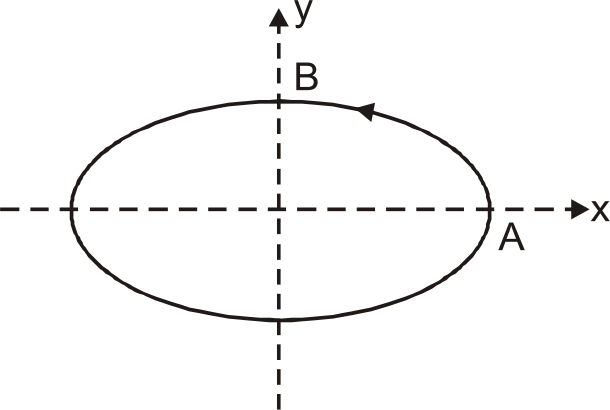A particle is moving along a circular path in xy-plane.When its crosses x-axis,it has an acceleration along the path of 1.5m/s2, and is moving with a speed of 10m/s in −ve y-direction.The total acceleration is

50ˆi−105ˆjm/s2
10ˆi−1.5ˆjm/s2
−50ˆi−1.5ˆjm/s2
1.5ˆi−50ˆjm/s2
The correct Answer is:C
a=ar(−ˆi)+at(−ˆj)
Topper's Solved these Questions
- BOOK - NARAYNACHAPTER - MOTION IN A PLANEEXERCISE - Level-I (H.W)41videos
MOTION IN A PLANE
- BOOK - NARAYNACHAPTER - MECHANICAL PROPERTIES OF SOLIDSEXERCISE - LEVEL-II (H.W)24videos
MECHANICAL PROPERTIES OF SOLIDS
- BOOK - NARAYNACHAPTER - MOTION IN A STRAIGHT LINEEXERCISE - Level 2 H.W29videos
MOTION IN A STRAIGHT LINE
Similar Questions
A particle is revolving in a circular path of radius 2 m with constant angular speed 4 rad/s. The angular acceleration of particle is
View SolutionA particle is moving on a circular path of radius 1 m with 2 m/s. If speed starts increasing at a rate of 2m/s2, then acceleration of particle is
View Solution
Knowledge Check
- Question 1 - Select One
If a particle is moving along a circular path with constant speed, then Its motion is
APeriodic and simple harmonicBNon periodicCPeriodic but not simple harmonicDNon periodic but simple harmonic - Question 2 - Select One
A particle is moving on a circular path with constant speed, then its acceleration will be
AZeroBExternal radial accelerationCInternal radial accelerationDConstant acceleration - Question 3 - Select One or More
A particle is moving along a circular path of radius of R such that radial acceleration of particle is proportional to t2 then
ASpeed of particle is constantBMagnitude of tangential acceleration of particle is constantCSpeed of particle is proportional to timeDMagnitude of tangential acceleration is variable
For a particle moving along a circular path with a constant speed, the accelerationis constant in
View SolutionA particle is moving along an elliptical path with constant speed. As it moves from A to B, magnitude of its acceleration :
 View Solution
View SolutionA particle is moving around a circular path with uniform angular speed (x) . The radius of the circular path is (r). The acceleration of the particle is:
View SolutionA particle moves with constant speed v along a circular path of radius r and completes the circle in time T. The acceleration of the particle is
View SolutionIf a body moves along circular path of constant radius, then the magnitude of its acceleration will be
View Solution

